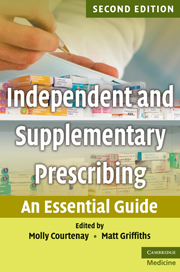Book contents
- Frontmatter
- Contents
- List of contributors
- Foreword to the second edition
- Preface to the second edition
- 1 Non-medical prescribing: an overview
- 2 Non-medical prescribing in a multidisciplinary team context
- 3 Consultation skills and decision making
- 4 Legal aspects of independent and supplementary prescribing
- 5 Ethical issues in independent and supplementary prescribing
- 6 Psychology and sociology of prescribing
- 7 Applied pharmacology
- 8 Monitoring skills
- 9 Promoting concordance in prescribing interactions
- 10 Evidence-based prescribing
- 11 Extended/supplementary prescribing: a public health perspective
- 12 Calculation skills
- 13 Prescribing in practice: how it works
- 14 Minimising the risk of prescribing error
- Index
- References
13 - Prescribing in practice: how it works
Published online by Cambridge University Press: 10 January 2011
- Frontmatter
- Contents
- List of contributors
- Foreword to the second edition
- Preface to the second edition
- 1 Non-medical prescribing: an overview
- 2 Non-medical prescribing in a multidisciplinary team context
- 3 Consultation skills and decision making
- 4 Legal aspects of independent and supplementary prescribing
- 5 Ethical issues in independent and supplementary prescribing
- 6 Psychology and sociology of prescribing
- 7 Applied pharmacology
- 8 Monitoring skills
- 9 Promoting concordance in prescribing interactions
- 10 Evidence-based prescribing
- 11 Extended/supplementary prescribing: a public health perspective
- 12 Calculation skills
- 13 Prescribing in practice: how it works
- 14 Minimising the risk of prescribing error
- Index
- References
Summary
Williams (1997) cites that at least 25% of the total population of the UK have a skin complaint, of which 19% will consult their GP. Therefore, caring for patients with dermatological conditions represents a significant workload for health professionals in primary care. Future dermatology services are aimed at improving dermatology services within primary care (DoH 2006) and reducing the waiting times for patients to be seen in secondary care (DoH 2008). This has already resulted in the development of nurse-led clinics in primary care for patients with chronic inflammatory skin disease (Bowcock and Bailey 2002; Mateos 2003; Page et al. 2009; Rolfe 2002a). Eczematous conditions, psoriasis and acne represent the three main chronic relapsing diseases which can be managed more effectively in a primary care setting (Page et al. 2009).
Recent legislative changes surrounding the prescription of medications will enable nurse-led clinics and pharmacy services to complement GP and secondary care dermatology services (Bowman 2000; DoH 1999; 2000; 2002; 2003; Medicines Control Agency 2002). For example, some of the topical and systemic medications used in dermatology are now available for nurses to prescribe independently. Furthermore, the advent of supplementary prescribing has meant that both nurses and pharmacists are able to prescribe from the British National Formulary (BNF 2009) for patients with dermatological conditions through the use of Clinical Management Plans (CMPs).
- Type
- Chapter
- Information
- Independent and Supplementary PrescribingAn Essential Guide, pp. 180 - 186Publisher: Cambridge University PressPrint publication year: 2010



